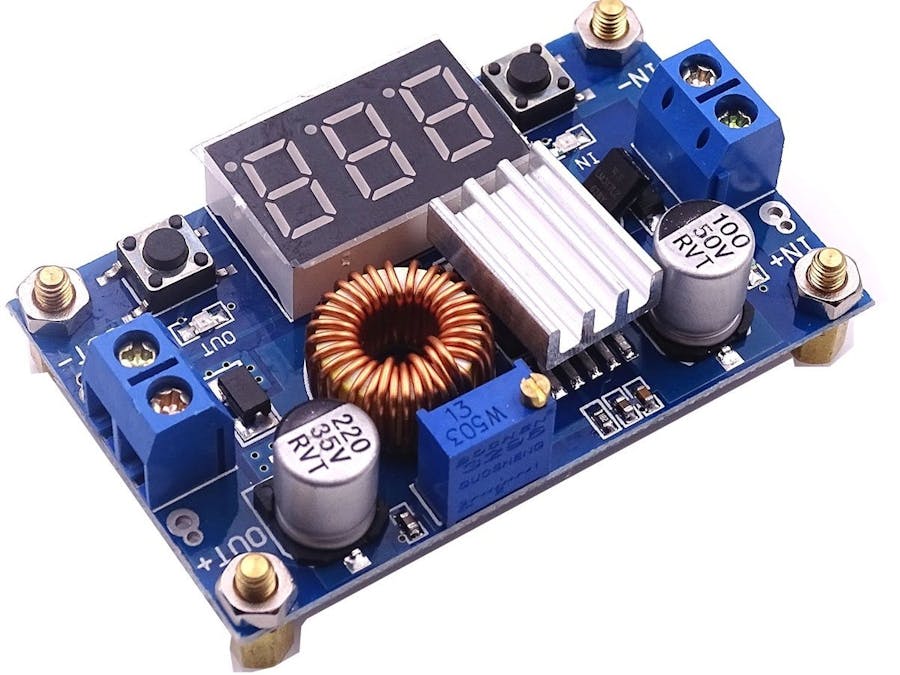We have all come across situations where we need a change of voltage which is lower because the power supply is of a different voltage. Luckily for us, it is possible to convert one DC voltage to another. Enter Buck Converters. These electronic modules can step down the voltage from its input to the output.
In this guide, we will see what are Buck converters and how todo these modules work.
Buck ConvertersA buck converter (step-down converter) is a DC-to-DC power converter that steps down voltage (while stepping up current) from its input (supply) to its output. It is a class of switched-mode power supply (SMPS) typically containing at least two and at least one energy storage element, a capacitor, inductor, or the two in combination. To reduce voltage ripple, filters made of capacitors are normally added to such a converter's output and input.
The basic operation of the buck converter has the current in an inductor controlled by two switches (usually a transistor and a diode). In the idealized converter, all the components are considered to be perfect. Specifically, the switch and the diode have zero voltage drop when on and zero current flow when off, and the inductor has zero series resistance.
Working of Buck ConvertorsThe conceptual model of the buck converter is best understood in terms of the relation between the current and voltage of the inductor. Beginning with the switch open (off-state), the current in the circuit is zero. When the switch is first closed (on-state), the current will begin to increase, and the inductor will produce an opposing voltage across its terminals in response to the changing current. This voltage drop counteracts the voltage of the source and therefore reduces the net voltage across the load. Over time, the rate of change of current decreases, and the voltage across the inductor also then decreases, increasing the voltage at the load. During this time, the inductor stores energy in the form of a magnetic field.
If the switch is opened while the current is still changing, then there will always be a voltage drop across the inductor, so the net voltage at the load will always be less than the input voltage source. When the switch is opened again, the voltage source will be removed from the circuit, and the current will decrease. The decreasing current will produce a voltage drop across the inductor, and now the inductor becomes a Current Source. The stored energy in the inductor's magnetic field supports the current flow through the load.
This current, flowing while the input voltage source is disconnected, when concatenated with the current flowing during on-state, totals to current greater than the average input current. The "increase" in average current makes up for the reduction in voltage and ideally preserves the power provided to the load. During the off-state, the inductor is discharging its stored energy into the rest of the circuit. If the switch is closed again before the inductor fully discharges, the voltage at the load will always be greater than zero.
Applications of Buck Convertors1. POL Converters for Laptops and PCs - A Point-Of-Load Converter, or POL, is a non-isolated buck converter that’s capable of efficiently driving power to high current loads. Modern microprocessors run off very low voltage, typically 1.8V.
2. Battery Chargers - typically, a charging port for a mobile device is a micro USB port. It accepts a regulated 5V. The charging circuits are on the inside of the mobile device, which is often a buck converter.
3. Solar Chargers - A solar charger is often a buck converter with a microcontroller control. The microcontroller tells the buck converter to draw the maximum amount of power by varying the load current to charge the battery in the shortest time possible.
4. Power Audio Amplifiers
The Step-Down converters can be used in other applications like it can be used as a battery charger, as a LED constant current driver module and is used in many electronic and communication equipment also.
Given below is a list of some of the best DC-DC step-down converters.
1. XL4015 5A DC-DC Step Down Adjustable Power Supply Buck Module LED with Heatsink
2. DC-DC Step-Down Buck Converter Power Supply Module 24V 12V 9V to 5V 5A 25W Replace LM2596S
3. Boost Buck Voltage LM2577S LM2596S DC-DC Step Up Down Power Converter Module
To explore more Buck converters at the Best PriceClick Here.






Comments
Please log in or sign up to comment.